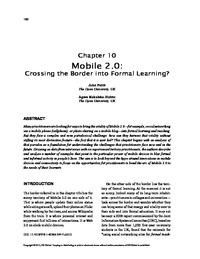Mobile 2.0Crossing the Border into Formal Learning?
John Pettit, Agnes Kukulska-Hulme
Zu finden in: Web 2.0-Based E-Learning, 2010
 |
 |
 Diese Seite wurde seit 13 Jahren inhaltlich nicht mehr aktualisiert.
Unter Umständen ist sie nicht mehr aktuell.
Diese Seite wurde seit 13 Jahren inhaltlich nicht mehr aktualisiert.
Unter Umständen ist sie nicht mehr aktuell.
 Zusammenfassungen
Zusammenfassungen
 Many practitioners are looking for ways to bring the vitality of Mobile 2.0—for example, social networking
via a mobile phone (cellphone), or photo sharing on a mobile blog—into formal learning and teaching.
But they face a complex and even paradoxical challenge: how can they harness that vitality without
stifling its most distinctive feature—the fact that it is user led? This chapter begins with an analysis of
that paradox as a foundation for understanding the challenges that practitioners face now and in the
future. Drawing on data from interviews with six experienced tertiary practitioners, the authors describe
and analyze a number of examples that point to the particular power of mobile devices to blur formal
and informal activity in people’s lives. The aim is to look beyond the hype around innovations in mobile
devices and connectivity to focus on the opportunities for practitioners to bend the arc of Mobile 2.0 to
the needs of their learners.
Many practitioners are looking for ways to bring the vitality of Mobile 2.0—for example, social networking
via a mobile phone (cellphone), or photo sharing on a mobile blog—into formal learning and teaching.
But they face a complex and even paradoxical challenge: how can they harness that vitality without
stifling its most distinctive feature—the fact that it is user led? This chapter begins with an analysis of
that paradox as a foundation for understanding the challenges that practitioners face now and in the
future. Drawing on data from interviews with six experienced tertiary practitioners, the authors describe
and analyze a number of examples that point to the particular power of mobile devices to blur formal
and informal activity in people’s lives. The aim is to look beyond the hype around innovations in mobile
devices and connectivity to focus on the opportunities for practitioners to bend the arc of Mobile 2.0 to
the needs of their learners. Dieser Text erwähnt ...
Dieser Text erwähnt ...
 Personen KB IB clear | Peter Morville | ||||||||||||||||||
 Begriffe KB IB clear |  cloud computing cloud computing cloud computing
, formal learningformal learning
, cloud computing
, formal learningformal learning
,  Geocaching Geocaching Geocaching
, informal learninginformal learning
, Geocaching
, informal learninginformal learning
,  Innovation Innovation innovation
, innovation
,  Lernen Lernen learning
, learning
,  Mobiltelefon Mobiltelefon mobile phone
, social bookmarkingsocial bookmarking mobile phone
, social bookmarkingsocial bookmarking
| ||||||||||||||||||
 Bücher |
|
 Tagcloud
Tagcloud
 Zitationsgraph (Beta-Test mit vis.js)
Zitationsgraph (Beta-Test mit vis.js)
 Anderswo finden
Anderswo finden
 Volltext dieses Dokuments
Volltext dieses Dokuments
 Anderswo suchen
Anderswo suchen 
 Beat und dieser Text
Beat und dieser Text
Beat hat Dieser Text während seiner Zeit am Institut für Medien und Schule (IMS) ins Biblionetz aufgenommen. Beat besitzt kein physisches, aber ein digitales Exemplar. (das er aber aus Urheberrechtsgründen nicht einfach weitergeben darf). Es gibt bisher nur wenige Objekte im Biblionetz, die dieses Werk zitieren.










 , 313 kByte)
, 313 kByte)  Biblionetz-History
Biblionetz-History